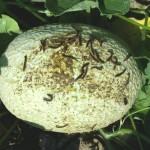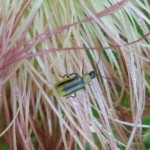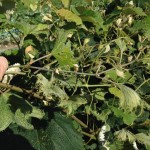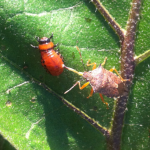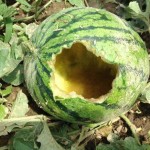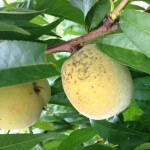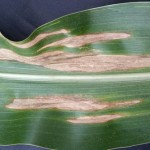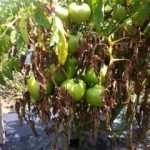Fruit:
Codling moth numbers increased again in several orchards this week, so growers will need to make follow up insecticide applications 10-14 days after the first biofix application. Fly speck, one of our summer fungal diseases was noted on some apples this week. Growers need to stay on a fungicide program to prevent both sooty blotch and fly speck disease development during the summer. All apple maggot traps remained negative the week of July 27-31. Green apple aphid populations were at high levels, above treatment thresholds, this week in several orchards. Other insects noted at below threshold levels in orchards included European red mites and leafminers. (See photo below)
Peaches are developing and some harvest is on-going. Oriental fruit moth trap captures remained high again this week in a couple of orchards, about the 5th week in a row that captures have been high. Growers are being encouraged to stay on a spray schedule to prevent damage from oriental fruit moth. Both the peach tree borer and lesser peach tree borer moth showed up again in trap captures in a couple of orchards the week of July 27-31. Growers have been advised to do some preventative treatment against borer damage. Growers are encouraged to maintain fungicide sprays to prevent brown rot and scab and are doing a good job with this because scouts are not noting any disease in orchards that are scouted.
Spotted wing drosophila (SWD) were caught in traps at 6 different locations during the week of July 27-31. Trap numbers ranged from 1 to 22. Commercial small fruit growers should be spraying ripe fruit and fruit that is beginning to ripen to protect against SWD infestation. Rotate between chemical classes of approved insecticides.
Other than SWD, powdery mildew is showing up in grapes and growers need to be on a fungicide program to prevent damage from this disease. (See photo below) Some very light levels of grape black rot were also noted by scouts this week. Fall red raspberries are ripening, blackberry harvest is underway and later maturing variety blueberries are being harvested.
Vegetables:
Lots of sunshine combined with hot temperatures this week. There were a few comments by scouts on their grower reports that plants needed water or were showing symptoms of moisture stress.
The most serious disease problems in both field and high tunnel grown tomatoes remain septoria leaf spot and early blight. Some early plantings have been finished off by the advances of these diseases. This week late blight was found and confirmed in a commercial tomato planting in Wayne County.
Bacterial spot and canker can be found in field tomatoes and growers are being advised to not work with the plants when they are wet, practice good sanitation between infected and non-infected plants and maintain a copper spray program to suppress the disease. In high tunnel production scouts are finding fusarium crown rot, Fusarium wilt, leaf mold, botrytis gray mold, timber rot and powdery mildew. Non-disease, environmental disorders that scouts are finding in both field and high tunnel production include yellow shoulder, catfacing and zippering.
Stink bug damage is being found on tomatoes and hornworms have been found in both high tunnel and field grown tomatoes. Scouts noted some moderate to high aphid numbers in a couple of tomato high tunnels this week.
Onions are being harvested and dried down for storage and garlic harvest is also underway.
Cole crops overall look good. Some of the new plantings for a planned fall harvest had imported cabbage worm numbers above treatment threshold and growers were advised to treat. Flea beetles were also noted on some of the new plantings, but not at economic treatment level. Established plantings are at the almost ready to harvest to harvest underway stage.
In vine crops, many plantings of summer squash and zucchini are being harvested regularly, fall squash and pumpkins are in bloom to some approaching harvest, cantaloupes are being harvested, watermelons range from fruit set to harvest, and cucumbers range from new plantings to harvest. Downy mildew was found in more cucumber fields this past week. Scouts also found more possible downy mildew in cantaloupe and sent a sample in to the vegetable pathology lab at OARDC for confirmation. Growers are being advised to use a fungicide spray program on a 5-7 day schedule to protect against downy mildew. Cucumbers are most vulnerable followed by cantaloupe and then squash, pumpkins and watermelon.
Powdery mildew is developing quickly on all vine crops and scouts were advising growers to get on and maintain a regular fungicide program to protect leaves and to protect developing fruit. Scouts noted plectosporium blight, as confirmed by the vegetable pathology lab at OARDC, on several plantings of pumpkins in several different fields across the county.
Bacterial wilt is being found both cucumbers as well as some fall squash and pumpkins. Cucumber beetles, the vector of the disease were noted at above threshold levels in younger cucumber, squash, zucchini, and pumpkin plantings and growers were being advised to treat to prevent bacterial wilt. Fusarium wilt is being found in some melons.
Angular leaf spot, a bacterial disease has been found across all vine crops and in many fields. Anthracnose and alternaria leaf spot have also been found and growers need to be on a good fungicide spray program. Phytophthora blight on squash fruit was found in one field.
Although not common, millipedes have been doing damage to some melons, primarily cantaloupe. Scouts also noted the presence of squash bug eggs and nymphs. Evidence of damage by squash vine borer was found on a few scattered plants. (See photo below)
Many pepper plantings are at the harvest stage. In some plantings, bacterial spot is present and bacterial soft rot has been observed. Scouts were finding a number of fruit with sunscald this past week as well as some blossom end rot. (See photo below) Scouts also noted mosaic virus in some plants this week. Grasshoppers and European corn borers were all found at low levels in some fields, along with damage from stinkbugs. Eggplant overall is doing well but there are plants with verticillium wilt and anthracnose. Colorado potato beetles and flea beetles were noted at above threshold levels in some field this week. Japanese beetles are present in low numbers.
Green beans vary from newly emerging to harvest. Defoliation generally below threshold damage levels by grasshoppers, and Japanese beetles have been noted, although in some isolated areas of some plantings defoliation by Japanese beetles is heavy.
Sweet corn, due to staggered plantings, ranges from V-4 to harvest. Only 1 corn earworm moth was caught between traps at 4 locations this week. European corn borer moth captures ranged from 0 to 9 between 4 trap locations the week of July 27-31. One corn earworm moth was captured between 4 trap locations. Feeding by slugs, European corn borer larvae, Japanese beetles and fall armyworm was noted by scouts this week. Japanese beetles are feeding on corn silks. The heaviest feeding damage is being done by deer and raccoon. Scouts continued to find Northern corn leaf blight and corn rust this week. (See photo below)
Potatoes overall look good and some are being harvested. Colorado potato beetle is at threshold levels in some plantings and under control in others. Low numbers of potato leaf hoppers and flea beetle were noted. Early blight and septoria leaf spot are showing up in some plantings. The occasional plant with blackleg is also being noted by scouts.
Agronomic Field Crops:
A lot of corn is in the R-1 to R-3 stage of development. Brown silks are beginning to show up in some fields, signaling an end to scouting. Northern corn leaf blight is being seen in some fields but at low levels, so far below what would be considered for a fungicide treatment. Japanese beetles and grasshoppers are all being noted at low levels in some fields. There was 1 western bean cutworm moth captured between 2 trap locations this past week. Also finding western corn root worm adults in some organic field corn silks. (See photo below) Deer and bird damage is also being noted.
In fields with good drainage soybeans look good and soybeans are at pod development, R3-4. Scouts are noting brown spot on the lower leaves of most soybean fields and seeing a few areas of Bacterial blight. (See photo below) White mold is starting to show up in pockets but generally low levels. Leaf defoliators including bean leaf beetle, Japanese beetles, grasshoppers and slugs have all been noted on scouting reports. Scouts are sweeping fields for stink bugs as they reach the R3 stage of development. Stink bugs were found at very low levels once again the week of July 27-31.
Alfalfa is being monitored for potato leaf hoppers. Populations are still low at this time. Alfalfa height ranges from 5 to 27 inches. A variety of insects are being noted in sweep net samples including aphids, grasshoppers, Japanese beetles, alfalfa plant bugs and clover worms. All are at levels below an economic treatment threshold. The bigger issue is some of the compaction damage that was done to some fields during a wet second cut harvest. Some plants have been lost and there are areas that are slow to recover.


